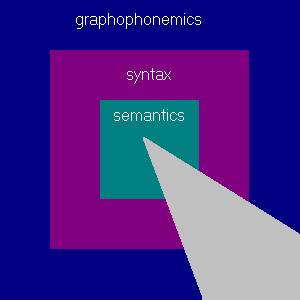

Language, for the sake of this webpage, is the uniquely human mode of communication. Computer languages, body language, "the language of..." will not be considered here; neither will mathematics, love, and smiles, which duke it out with Esperanto for the title of "universal language". To be technical, language is "a system of rules that relate sound sequences to meanings" (Ornstein et. al., 1979). Or, to be more inclusive, "a system of rules that relate sign and sound sequences to meanings." (This includes sign language, writing, and speech.)
This website not meant to dispel all myths or answer all questions about language; such a task has yet to be accomplished. Rather, it is an introduction--and a slim one, at that--into the realm of linguistics.
Phonology
Phonology is concerned with the patterns of sound
that carry meaning--phonemes. A phoneme consists of a sound "family";
all of these sounds are phonetically similar. Phonemes are defined
as phonic segments that
a. have a distinctive function
b. cannot be decomposed into smaller units with
distinctive functions
c. is defined only by those characteristics that
differentiate it from other phonemes (Ducrot & Tudorov, 1972).
English has approximately 45 phonemes (Hayes,
Ornstein, & Gage, 1987).
Phonemes interact within words according to specific
patterns or rules; phonology is an attempt to discover, label, and explicate
these rules.
For a look at the International Phonetic Alphabet, click here.
Morphology
Morphology is the study of word formation and structure. Just as phonology is the study of phonemes, morphology is the study of morphemes--the irreducible unit of meaning. Morphemes come in various sizes; they can be as small as one letter or as large as an entire word. For example, the word "irreducible" has three morphemes:
ir + re + duc + ible
ir = "not"; re = "again"; duc (from Latin ducere) "to lead"; ible = "able to be ..."
Some theorists, Noam Chomsky in particular, combine phonology and morphology as dual aspects of single entity, often called "morphophonology."
Syntax
Syntax is sentence structure (or the study thereof). The words "grammar" and "syntax" are often used interchangeably in linguistic texts. Syntax is often described in sets of rules, and diagrammed using varying methods. Languages are often broken down into eight structural components or "parts of speech," including nouns, verbs, adverbs, adjectives, pronouns, prepositions, conjunctions, and interjections.
Semantics
Semantics is the study of meaning. The difference between syntax and semantics is not always obvious when trying to determine sentence function; after all, the differences in varying structural components are also differences in meaning. Harste et al. (1984) claim that semantics is the core of language; meaning "drives the system." A diagram below:

Learning occurs as a transaction of all three systems.
Language Acquisition
How do children learn to speak an incredibly complex language? How do people learn a second? The study of language acquistion attempts to answer these questions. After Noam Chomsky developed the theory of Universal Grammar (or UG), linguists began to focus on the transaction of innate language ability and a language-filled environment. This aspect of linguistics is hotly contested; empiricists will concede that a general learning ability is innate in the brain (and would be foolish not to), but do not propose as specific "language acquisition device." New computer models of brain functioning have shed new light on acquisition theory. (See "neurolinguistics," below.)
Sociolinguistics: This is the study of language use in different societies, as well as effects language differences have on society. Also called anthropological linguistics or ethnolinguistics, it asks questions such as: How does language affect culture, and vice versa? How can we translate unknown languages into our own while preserving meaning?
Neurolinguistics. Advances in the study of the brain (Positon Emission Tomography, fMRI, CAT scans) have given linguists a real-time view of language in the brain. Neurolinguistics attempts to determine which regions of the brain control language (most recently: all of them, in very complex interactions). Much of the work in this area centers on specific brain damage as tied to specific language disabilities.
Closely related to the above is psycholinguistics, the study of the psychological processes involved in language use and development. The work of Piaget and Vygotsky falls into this category.
Evolutionary linguistics: What are the evolutionary roots of language? Do patterns in animal development tell us anything about the nature of language use?
Pragmatics: Pragmatics is the study of meaning in context, or how language is used to perform specific functions.
Comparative / Historical Linguistics: What can be learned about the nature of human language through comparison of different language? Can we discover a "universal grammar" that works for all languages? What can we tell about the origins of modern languages by comparing their syntax and lexicon? Can we delineate the structure and function of a "protolanguage"? As the Random House College Dictionary puts it, the comparative method... "can illumine not only ancient ways of life but also ancient modes of thought" (1579).
Semiotics is the study of sign systems or symbols. Practitioners include(d) C.S. Peirce and Ferdinand de Saussure (who called his branch "semiology").
Philosophy of Language. The domain of Plato, Wittgenstein, Aquinas, Locke, Russell, and nearly every philosopher who has ever attempted to figure out the relationship of ideas to words, or how language affects reasoning, action, and existence. Deconstruction, at the moment, is all the rage.
Harste, J.; Woodward, V.; Burke, C. (1984). Language Stories and Literacy Lessons. Portsmouth, NH: Heinemann Educational Books.
Hayes, C.; Ornstein, J.; Gage, W. (1987). The ABC's of Languages and Linguistics: A Basic Introduction to Language Science. Lincolnwood, IL: National Textbook Company.
Johnson, F. (2000). Speaking Culturally: Language Diversity in the United States. Thousand Oaks, CA: Sage Publications, Inc.
Sampson, G. (1997). Educating Eve: The 'Language Instinct' Debate. London: Cassell.
Vygotsky, L. (1962). Thought and Language. Cambridge, MA: The MIT Press.